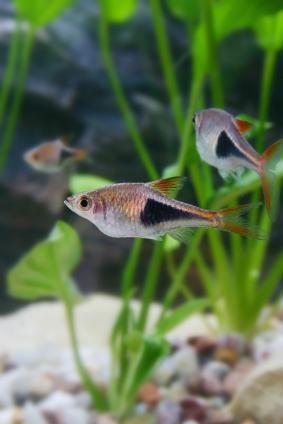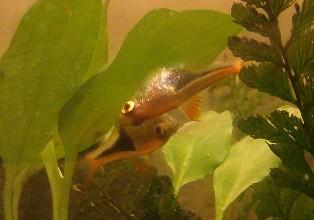Rasbora (Harlequin Fish)

Rasboras (Rasbora heteromorpha) are also called harlequin fish or harlequin rasboras. Rasboras originate from Thailand and belong to the family Cyprinidae. There are several other species of fish that belong to the genus Rasbora besides R. Heteromorpha, however, the description that follows is only for R. Heteromorpha.
Rasboras are peaceful, shoaling fish that need to be kept in a small group of 4-8 fish in order for them to thrive and be happy.
They reach an adult size of 1.5-1.75 inches in length (3.8-4.5 cm) and primarily inhabit the mid to upper levels of the aquarium. Their water should be soft and slightly acidic. Their water temperature should be about 75 °F (23-24 °C).
Rasboras eat most aquarium fare: freeze-dried, flake, live, or frozen food. Feeding them meaty foods will help them get into breeding condition.
To encourage spawning you need to have the male-female pair in a separate breeding tank. Sexing rasboras is fairly easy - you can usually tell males from females because the males have thinner bodies than the females, and the black triangular region on the male's body has a more defined or angular edge than the females do. Also, on the males, this black region extends further along the lower abdomen than on the females.
The rasbora breeding tank should be heavily planted, and should include some broad-leaved plants. The water should be soft and slightly acidic. You should filter their water through peat if you want them to spawn.

Spawning Rasboras (photo by Faye Washington)
At first the male rasbora will chase the female around the tank. Eventually, spawning will take place underneath a leaf, and the eggs will be placed on the underside of a broad leaf. Once spawning is complete remove the rasbora pair.
You should darken the tank containing the rasbora eggs by placing paper around the tank while you are waiting for the rasbora eggs to hatch and the fry to become free-swimming (although I'd check on the eggs and fry at least once a day while you are waiting for them to become free-swimming).
The eggs will hatch in about 24 hours. The fry will become free-swimming in about 3 days. Once they are free-swimming, feed them infusoria or rotifers (if you have them). If you don't have access to either of these foods then you could try commercial liquid fry food for egg layers. Feed them newly hatched brine shrimp when they are a little older (in about a week).
